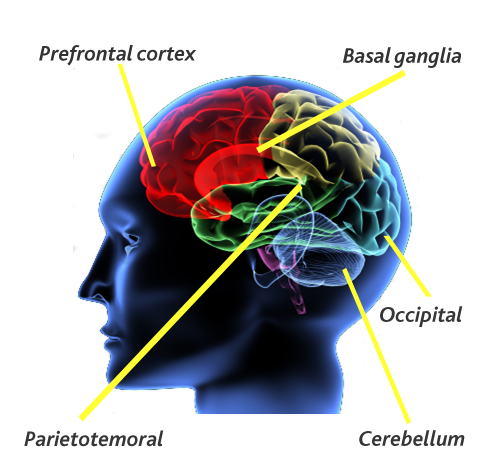We successfully help neurological status by improving wellness as a whole. If functional brain deficits are at the core of your departure from wellness, we utilize specialized brain training to improve brain function while supporting the other components of wellness.
How the Brain Grows and Develops
We are not born with fully developed brains; brain morphogenesis continues well after birth. The brain grows from back to front and from midline, out. More primitive areas of the brain develop first and the newest areas of the brain, which are responsible for higher-level thinking, develop at a later stage.
What makes our brains different from other life forms is not structure alone, but also how our brains function. Functional development of behavioral and cognitive skills too have a specific sequence; as each stage is built upon the last. It stands to reason that if a stage develops aberrantly or is skipped completely, the stages that follow will be affected negatively.
In regard to functional deficits which contribute to emotional, behavioral, social, and cognitive problems, there are distinct areas of the brain that play a critical role; the cerebellum, the basal ganglia, the occipital, parietal, temporal and frontal lobes to name a few.
Read more about about the brain areas mentioned above
 Cerebellum
Cerebellum
Located in the back of the brain, the cerebellum was once thought to be responsible only for coordinating and refining movement. We now know that the cerebellum also assists in refining our thought processes. Besides refinement and coordination, the cerebellum’s helps to synchronize activity between the two hemispheres of the brain. The cerebellum in conjunction with the “inferior olivary nuclei” help set the baseline frequency of brain function. If they are out of sync, the rest of the brain’s processing will be out of sync as well.
The Basal Ganglia
As their name suggests, the basal ganglia consist of a set of neural structures buried deep inside the brain. They are closely tied to the reward centers of the brain and play a role in allowing and inhibiting certain actions from occurring.
The basal ganglia influence a number of functions. It has been linked to voluntary motor control, procedural learning relating to routine behaviors or “habits”, OCDs, eye movements, tics, as well as cognitive and emotional functions.
Occipital Lobes
A significant functional aspect of the occipital lobe is that it contains the primary visual cortex. The work of the occipital lobe includes visual perception, motion detection and color discrimination.
Parietal Lobes
Within the parietal lobe is the sensory cortex, where the brain reacts to information from touch, pressure, temperature and pain. The parietal lobe plays important roles in integrating sensory information from various parts of the body. It is also integral in the movement of specific body parts. It receives sensory input from the body and eyes which gives feedback to the motor system located in the frontal lobes, this feedback plays a role in coordinating our movements. Portions of the parietal lobe are also involved with visuo-spatial processing.
Temporal Lobes
The temporal lobes lie at the sides of the brain separated by the lateral or Sylvian fissure, the deepest and most prominent of the cortical fissures. The temporal lobe processes auditory input and is primarily involved in deciphering the meaning of auditory and visual information. The temporal lobe is involved in forming hearing and auditory memories and many agree it is primarily responsible for the formation of new memories associated with experiences. Its medial portion called the hippocampus plays important roles in the consolidation of information from short-term memory to long-term memory and spatial navigation
The hippocampus also belongs to the limbic system. The limbic system operates by influencing the endocrine system and the autonomic nervous system. It is highly interconnected with the brain’s pleasure center, which plays a role in sexual arousal and the “high” derived from certain recreational drugs.
The limbic system is also tightly connected to the prefrontal cortex. Some scientists contend that this connection is related to the pleasure obtained from solving problems. To cure severe emotional disorders, this connection was sometimes surgically severed, a procedure of psychosurgery, called a prefrontal lobotomy (this is actually a misnomer). Patients who underwent this procedure often became passive and lacked all motivation.
Frontal Lobes
Found in the anterior portion of the frontal lobes the prefrontal cortex is the most evolved area of the brain and as such it is the last to develop. This brain region gives an individual the capacity to exercise “good judgment” when presented with difficult life situations. Brain research indicating that brain development is not complete until near the age of 25 refers specifically to the development of the prefrontal cortex. It is often referred to as the “CEO of the brain, as it gradually becomes able to oversee and regulate the behavioral responses initiated by the more primitive limbic structures as well as supervise other complex brain activities.
The so-called “executive functions” of the human prefrontal cortex include:
Focusing attention
Organizing thoughts and problem solving
Simultaneously considering multiple streams of information when faced with complex and challenging information
Considering the future and making predictions
Forming strategies and planning
Initiating and halting thoughts and actions
Shifting/adjusting behavior when situations change (transitioning)
Impulse control and delaying gratification
Ability to balance short-term rewards with long term goals
Modulation of emotions
Inhibiting inappropriate behavior and initiating appropriate behavior
Foreseeing and weighing possible consequences of behavior
Neuroplasticity: The Brain Can Change
The  scientific community has studied the brain for hundreds of years. While the structure and organization of the brain obviously changes during childhood, it has long been believed that it remains unchanged after adulthood is reached. Continued learning, then, was thought to occur when the strength of neural connections increased.
scientific community has studied the brain for hundreds of years. While the structure and organization of the brain obviously changes during childhood, it has long been believed that it remains unchanged after adulthood is reached. Continued learning, then, was thought to occur when the strength of neural connections increased.
Over the last few decades, however, researchers have discovered that the brain has the ability to fundamentally reorganize itself when confronted with new challenges, and that this can occur regardless of age. Through targeted, repetitious and progressively challenging activities, the brain can actually reshape itself to become more efficient. This reshaping, known as “neuroplasticity”, gives new hope to anyone suffering from physical, emotional, attentional, and cognitive challenges.
The brain is a highly complex, interacting, and integrated system. Engaging in tasks of daily living – going to school, working, caring for family, etc. – requires proper functioning of all aspects of the brain in unison. Therefore, addressing limited aspects of brain function, such as visual attention, auditory processing, or balance and equilibrium, in isolation is unlikely to create enough neuroplastic changes to yield optimal results for real world function.
Dr Norman Doidge speaking about Neuroplasticity |
A fun video describing Neuropasticity |
